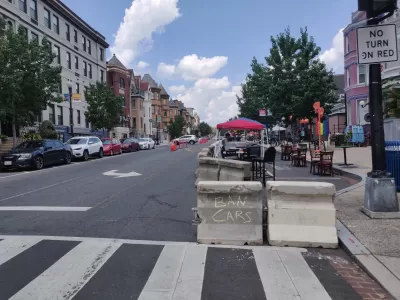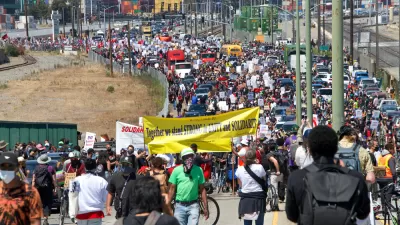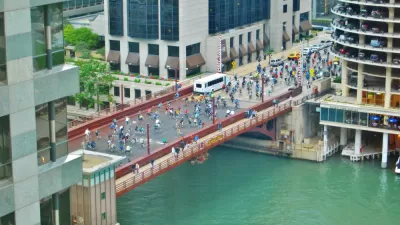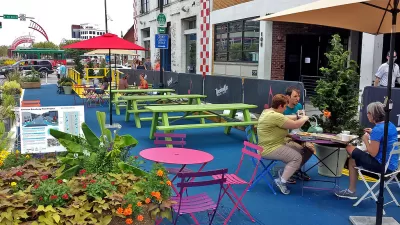Slow streets programs provided a quick short-term solution and paved the way for some permanent street closures and realignments. Now, these programs are getting a second look as community groups react to the changes.

In a piece for Bloomberg CityLab, Laura Bliss assesses the explosive growth of Slow Streets in 2020 and the impacts of the quick rollout of street closure programs on communities of color.
When Oakland implemented a Slow Streets program in April, many planners and residents lauded its quick rollout and positive effects on walking and biking safety. But a survey showed that "while affluent, white and non-disabled residents were overwhelmingly proponents of the program, people of color, people with lower incomes, and people with disabilities reported much lower levels of awareness, use and support." Some residents felt confused and taken by surprise, claiming the city didn't engage in thorough outreach to the residents on the affected streets. Others pointed to the deaths of Black men and women in the public right-of-way at the hands of police as a reminder that safety on public streets often looks different for people of color.
Bliss writes that "the anger was palpable in long follow-up meetings spent with community groups." If the solution is unclear, the disconnect is obvious. "At this point..... #OaklandSlowStreets need to come to an end," tweeted an East Oakland bike nonprofit in May. Warren Logan, the director of mobility policy and interagency relations in the Oakland mayor’s office, pointed to that tweet, among similar messages, as an example of the gulf between city planners and the community. "If he’s upset about what I thought was a bike-friendly program, then we’re obviously missing something."
Following the backlash, the city worked with community groups to revise the Slow Streets program, adding more public input on street selection, updating street closure signage and developing clearer messaging. "Critics give the city credit for persistence," writes Bliss, but think the city has done little so far to make real change. Slow streets programs in other cities faced similar resistance. In Seattle, residents of historically Black neighborhoods said the program signage made them feel excluded and "triggered at least one uncomfortable confrontation."
"In a year that has put police departments in the spotlight for their legacies of brutalizing Black communities, there has also been a quieter reckoning over the fact that those who configure streets, build highways and fund housing can have an equally profound impact on communities of color — often negative." Planners have to balance the urge to seize the opportunities presented by the pandemic and implement projects quickly with the profession's "history of trauma" and the critical need for establishing trust and true dialogue with the communities affected by their decision-making.
FULL STORY: ‘Slow Streets’ Disrupted City Planning. What Comes Next?

Planetizen Federal Action Tracker
A weekly monitor of how Trump’s orders and actions are impacting planners and planning in America.

Congressman Proposes Bill to Rename DC Metro “Trump Train”
The Make Autorail Great Again Act would withhold federal funding to the system until the Washington Metropolitan Area Transit Authority (WMATA), rebrands as the Washington Metropolitan Authority for Greater Access (WMAGA).

The Simple Legislative Tool Transforming Vacant Downtowns
In California, Michigan and Georgia, an easy win is bringing dollars — and delight — back to city centers.

The States Losing Rural Delivery Rooms at an Alarming Pace
In some states, as few as 9% of rural hospitals still deliver babies. As a result, rising pre-term births, no adequate pre-term care and "harrowing" close calls are a growing reality.

The Small South Asian Republic Going all in on EVs
Thanks to one simple policy change less than five years ago, 65% of new cars in this Himalayan country are now electric.

DC Backpedals on Bike Lane Protection, Swaps Barriers for Paint
Citing aesthetic concerns, the city is removing the concrete barriers and flexposts that once separated Arizona Avenue cyclists from motor vehicles.
Urban Design for Planners 1: Software Tools
This six-course series explores essential urban design concepts using open source software and equips planners with the tools they need to participate fully in the urban design process.
Planning for Universal Design
Learn the tools for implementing Universal Design in planning regulations.
Smith Gee Studio
City of Charlotte
City of Camden Redevelopment Agency
City of Astoria
Transportation Research & Education Center (TREC) at Portland State University
US High Speed Rail Association
City of Camden Redevelopment Agency
Municipality of Princeton (NJ)





























